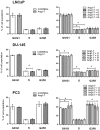Angiotensin 1-7 modulates molecular and cellular processes central to the pathogenesis of prostate cancer
- PMID: 30361641
- PMCID: PMC6202343
- DOI: 10.1038/s41598-018-34049-8
Angiotensin 1-7 modulates molecular and cellular processes central to the pathogenesis of prostate cancer
Abstract
Angiotensin 1-7 (Ang1-7) is an endogenous bioactive component of the renin-angiotensin system (RAS). In addition to its cardiovascular properties, its anti-proliferative and anti-angiogenic traits are believed to play important roles in carcinogenesis. The present study examines the influence of Ang1-7 on processes associated with development and progression of prostate cancer cells. Our findings indicate that while Ang1-7 (1 nM; 48 h) can effectively reduce cell proliferation in DU-145, it can induce a significant decrease in the expression of MKI67 in LNCaP. In both cell lines we also observed a reduction in colony size in soft agar assay. A various changes in gene expression were noted after exposure to Ang1-7: those of anti- and pro-apoptotic agents and the NF-kB family of transcription factors, as well as mesenchymal cell markers and vascular endothelial growth factor A (VEGFA). In addition, Ang1-7 was found to modulate cell adhesion and matrix metallopeptidase (MMP) activity. Changes were also observed in the levels of angiotensin receptors and sex steroid hormone receptors. Ang1-7 reduced the levels of estrogen receptor alpha gene (ESR1) and increased the expression of estrogen receptor beta gene (ESR2) in all prostate cancer cells; it also up-regulated androgen receptor (AR) expression in androgen-sensitive cells but contradictory effect was observed in androgen- irresponsive cell lines. In summary, the results confirm the existence of complex network between the various elements of the local RAS and the molecular and cellular mechanisms of prostate cancerogenesis. The response of cancer cells to Ang1-7 appears to vary dependently on the dose and time of incubation as well as the aggressiveness and the hormonal status of cells.
Conflict of interest statement
The authors declare no competing interests.
Figures






Similar articles
-
The Impact of Ang-(1-9) and Ang-(3-7) on the Biological Properties of Prostate Cancer Cells by Modulation of Inflammatory and Steroidogenesis Pathway Genes.Int J Mol Sci. 2020 Aug 28;21(17):6227. doi: 10.3390/ijms21176227. Int J Mol Sci. 2020. PMID: 32872192 Free PMC article.
-
The opposite effects of angiotensin 1-9 and angiotensin 3-7 in prostate epithelial cells.Biochem Biophys Res Commun. 2019 Nov 19;519(4):868-873. doi: 10.1016/j.bbrc.2019.09.079. Epub 2019 Sep 25. Biochem Biophys Res Commun. 2019. PMID: 31563322
-
Influence and mechanism of Angiotensin 1-7 on biological properties of normal prostate epithelial cells.Biochem Biophys Res Commun. 2018 Jul 7;502(1):152-159. doi: 10.1016/j.bbrc.2018.05.138. Epub 2018 May 26. Biochem Biophys Res Commun. 2018. PMID: 29802847
-
Growth hormone-releasing hormone (GHRH) promotes metastatic phenotypes through EGFR/HER2 transactivation in prostate cancer cells.Mol Cell Endocrinol. 2017 May 5;446:59-69. doi: 10.1016/j.mce.2017.02.011. Epub 2017 Feb 11. Mol Cell Endocrinol. 2017. PMID: 28193499
-
In vitro modulation of tumor progression-associated properties of hormone refractory prostate carcinoma cell lines by cytokines.Cancer. 1996 May 1;77(9):1862-72. doi: 10.1002/(SICI)1097-0142(19960501)77:9<1862::AID-CNCR16>3.0.CO;2-Y. Cancer. 1996. PMID: 8646686
Cited by
-
The Influence of Angiotensin Peptides on Survival and Motility of Human High-Grade Serous Ovarian Cancer Cells in Serum Starvation Conditions.Int J Mol Sci. 2021 Dec 21;23(1):52. doi: 10.3390/ijms23010052. Int J Mol Sci. 2021. PMID: 35008474 Free PMC article.
-
Alterations in Gene Expression of Renin-Angiotensin System Components and Related Proteins in Colorectal Cancer.J Renin Angiotensin Aldosterone Syst. 2021 Jul 5;2021:9987115. doi: 10.1155/2021/9987115. eCollection 2021. J Renin Angiotensin Aldosterone Syst. 2021. PMID: 34285715 Free PMC article.
-
Reduction of Prostate Cancer Risk: Role of Frequent Ejaculation-Associated Mechanisms.Cancers (Basel). 2025 Feb 28;17(5):843. doi: 10.3390/cancers17050843. Cancers (Basel). 2025. PMID: 40075690 Free PMC article. Review.
-
The Impact of Ang-(1-9) and Ang-(3-7) on the Biological Properties of Prostate Cancer Cells by Modulation of Inflammatory and Steroidogenesis Pathway Genes.Int J Mol Sci. 2020 Aug 28;21(17):6227. doi: 10.3390/ijms21176227. Int J Mol Sci. 2020. PMID: 32872192 Free PMC article.
-
Prognostic and Immunological Value of Angiotensin-Converting Enzyme 2 in Pan-Cancer.Front Mol Biosci. 2020 Sep 1;7:189. doi: 10.3389/fmolb.2020.00189. eCollection 2020. Front Mol Biosci. 2020. PMID: 33088807 Free PMC article.
References
-
- Domińska K, Lachowicz-Ochedalska A. The involvement of the renin-angiotensin system (RAS) in cancerogenesis. Postepy Biochem. 2008;54:294–300. - PubMed
Publication types
MeSH terms
Substances
LinkOut - more resources
Full Text Sources
Medical
Research Materials
Miscellaneous

